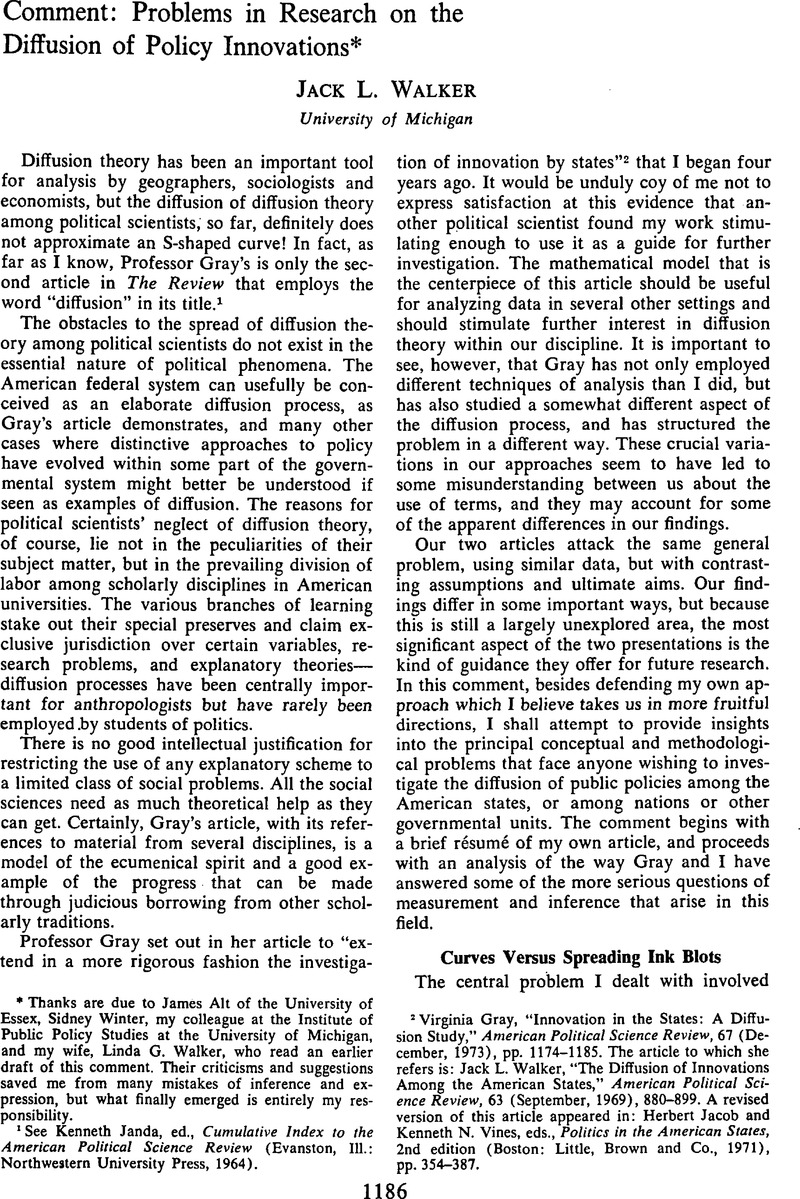Article contents
Comment: Problems in Research on the Diffusion of Policy Innovations*
Published online by Cambridge University Press: 01 August 2014
Abstract

- Type
- Article Commentary
- Information
- Copyright
- Copyright © American Political Science Association 1973
Footnotes
Thanks are due to James Alt of the University of Essex, Sidney Winter, my colleague at the Institute of Public Policy Studies at the University of Michigan, and my wife, Linda G. Walker, who read an earlier draft of this comment. Their criticisms and suggestions saved me from many mistakes of inference and expression, but what finally emerged is entirely my responsibility.
References
1 See Janda, Kenneth, ed., Cumulative Index to the American Political Science Review (Evanston, Ill.: Northwestern University Press, 1964)Google Scholar.
2 Gray, Virginia, “Innovation in the States: A Diffusion Study,” American Political Science Review, 67 (December, 1973), pp. 1174–1185 CrossRefGoogle Scholar. The article to which she refers is: Walker, Jack L., “The Diffusion of Innovau'ons Among the American States,” American Political Science Review, 63 (September, 1969), 880–899 CrossRefGoogle Scholar. A revised version of this article appeared in: Jacob, Herbert and Vines, Kenneth N., eds., Politics in the American States, 2nd edition (Boston: Little, Brown and Co., 1971), pp. 354–387 Google Scholar.
3 Gray, p. 1185.
4 Gray, p. 1176, 1179.
5 Gray, pp. 1176, 1179, and footnotes number 21, 23 and 25.
6 Gray, p. 1180.
7 These data are provided by Gray in Table 5, p. 1184.
8 The phrase “interaction effects” is being used as it was in: Forbes, Hugh Donald and Tufte, Edward R., “A Note of Caution in Causal Modelling,” American Political Science Review, 62 (December, 1968), 1261–1262 CrossRefGoogle Scholar. For similar commentary see the discussions of the “universal fallacy” and the “contextual fallacy” in Alker, Hayward R. Jr., Mathematics and Politics (New York: Macmillan, 1965), pp. 101–106 Google Scholar.
9 For a more lengthy presentation of this view, see; Riley, Dennis and Walker, Jack L., “Communication,” American Political Science Review, 63 (September, 1969), 900–903 CrossRefGoogle Scholar. For an interesting discussion of analytical problems created by regionalism, see: Sullivan, John L., “Political Correlates of Social, Economic, and Religious Diversity in the American States,” The Journal of Politics (February, 1973), pp. 70–84 CrossRefGoogle Scholar.
10 Gray, pp. 1183–1185.
11 For a review of diffusion research that includes an extensive bibliograpry of more than 1,500 items see: Rogers, Everett M. and Shoemaker, F. Floyd, Communication of Innovations: A Cross-Cultural Approach (New York: Free Press, 1971)Google Scholar.
12 The body of theory upon which I drew is summarized best in Taylor, Donald W., “Decision Making and Problem Solving” in Handbook of Organizations, ed. March, James G. (Chicago: Rand McNally, 1965), pp. 48–86 Google Scholar. Also see: Julia Feldman and Herschel E. Kanter, “Organizational Decision Making,” Ibid., pp. 614–649; Scott, W. Richard, “Theory of Organizations” in Handbook of Modern Sociology, ed. Faris, Robert E. L. (Chicago: Rand McNally, 1964), pp. 485–529 Google Scholar; and Mohr, Lawrence B., “Determinants of Innovation in Organizations,” American Political Science Review, 63 (January, 1969), 111–126 CrossRefGoogle Scholar.
13 For a discussion of the genesis of the latter program and reactions to it in other parts of the country, see: Hopper, Columbus B., Sex in Prison: The Mississippi Experiment with Conjugal Visiting (Baton Rouge: The Louisiana State University Press, 1971)Google Scholar.
14 For an insightful article that illustrates this point in reference to innovations in public health, see: Becker, Marshall H., “Sociometric Location and Innovativeness: Reformulation and Extension of the Diffusion Model,” American Sociological Review (April, 1970), pp. 267–282 CrossRefGoogle Scholar.
15 For a more extensive discussion of this problem see: Warner, Kenneth E., “The Need for Some Innovative Concepts of Innovation: An Agenda for Research” (Working Paper Prepared for Faculty Seminar on Innovation and Social Change, Institute of Public Policy Studies, University of Michigan, 1972)Google Scholar.
16 This literature is reviewed in Raymond E. Wolfinger, “Nondecisions and the Study of Local Politics,” Frederick W. Frey, “Comment: On Issues and Non-issues in the Study of Power”; and Wolfinger, Raymond E., “Rejoinder to Frey's Comment,” American Political Science Review, 65 (December, 1971), 1063–1104 CrossRefGoogle Scholar.
17 I refer to: Elazar, Daniel J., American Federalism: A View From the States (New York: Crowell, 1966)Google Scholar; and Banfield, Edward C. and Wilson, James Q., City Politics (Boston: Harvard University Press, 1963)Google Scholar. Also see: Wolfinger, Raymond E. and Greenstein, Fred I., “Comparing Political Regions: The Case of California,” American Political Science Review, 63 (March, 1969), 74–85 CrossRefGoogle Scholar.
18 Two recent studies that include interesting efforts to explain the origins of policy are: Crenson, Matthew A., The Unpolitics of Air Pollution (Baltimore: Johns Hopkins University Press, 1971)Google Scholar; and Nadel, Mark, The Politics of Consumer Protection (Indianapolis: Bobbs-Merrill, 1972)Google Scholar.
19 For a study of the international diffusion of social security programs see: Collier, David and Messick, Richard E., “Functional Prerequisites Versus Diffusion: Testing Alternative Explanations of Social Security Adoption,” (Paper Delivered at the 1973 Annual Meeting of the Midwest Political Science Association, Chicago, Illinois)Google Scholar.
- 43
- Cited by




